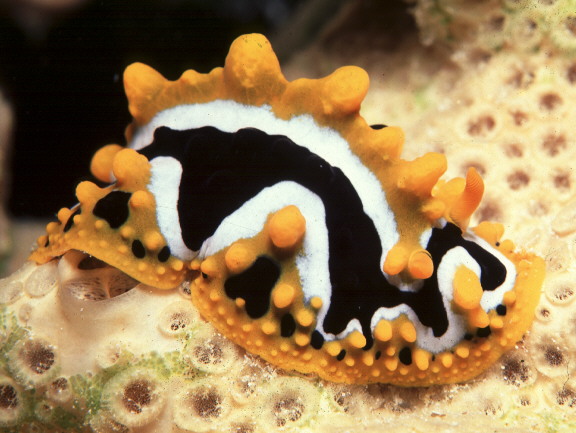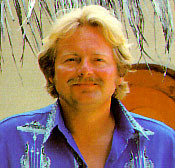
Phyllidia ocellata
Phyllidia ocellata Cuvier, 1804
As seen on pages 260-263 in Helmut Debelius' book, Nudibranchs & Sea Snails, Indo-Pacific Field Guide, Phyllidia ocellata is highly variable in coloration. As an additional example of this variation, consider a dramatic picture of P. ocellata taken in southeastern Papua New Guinea by Mary Jane Adams of Arcadia, Calif. Probably the most striking member of this genus of porostome dorid nudibranchs, the gills are not dorsally located, as in all other dorid groups, but located laterally under the mantle.
As mentioned in Cuvier's original description, P. ocellata can easily be separated from other Phyllidids by the tall knobby tubercles on the dorsal surface of the mantle and the 4-10 black rings bordered in white with a gold or white tubercles in the center. Some variation in the presence and number of tubercles has been observed, and in some specimens the characteristic rings may be replaced by an undulating line, as seen in the above photograph.
Measuring up to 6 cm in length, this species is found in shallow water to 20 meters, often conspicuously out in the open.
P. ocellata's bright coloration is a perfect example of aposematic or "warning" coloration in nudibranchs advising wanton predators that it gives off noxious chemicals if disturbed or eaten.
As in other porostomata, Phyllidia lack radular teeth and feed by secreting digestive enzymes into sponges, then suck the partially digested tissue into their gut.
This species is widely distributed from Tanzania; Reunion Islands; Seychelles; Red Sea to Australia; Fiji; Solomon Islands; New Guinea; Indonesia; the Philippines; Guam; Okinawa; southern Japan and the Marshall Islands.
Photo courtesy of Helmut Debelius, Frankfurt, Germany:

The photo above is part of his most recent publication, Indo-Pacific Field Guide of Nudibranchs and Sea Snails, containing over 1000 photographs of marine snails taken in their natural habitat . The book excels in rarely seen behavioral aspects of marine sea slugs. For book ordering information.
Send Helmut e-maill at IKANUW@aol.com
|
Photo courtesy of Mary Jane Adams, Arcadia, Calif

Send Mary Jane mail at mjadams@earthlink |
Taxonomic information courtesy of:

David W. Behrens
Author:
Pacific Coast Nudibranchs
Send Dave mail at seachalleng@earthlink.net
|
